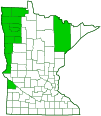silverberry
(Elaeagnus commutata)
Conservation • Wetland • Description • Habitat • Ecology • Use • Distribution • Taxonomy
Description |
||
Silverberry is an erect, long-lived, perennial shrub that rises on a single stem from a strong rhizome. It sometimes forms thickets. It can be from 3½′ to 13′ tall at maturity, though in Minnesota it is usually no more than 6′ in height. The bark on young plants is gray or grayish-brown. On mature plants the bark becomes rough and scaly. First-year branches are densely covered with shiny, brown, bran-like scales. Second-year branches are ashy gray. There are no thorns. The leaves are alternate, deciduous, elliptical, 1⅜″ to 2½″ long, and ⅝″ to 1⅜″ wide. They are on scaly, ⅛″ to ¼″ long leaf stalks. The upper surface is covered with silvery, bran-like scales. The lower surface is covered with silvery, bran-like scales and often also has a few reddish scales. The margins are untoothed. The scales give the leaves a metallic appearance. The inflorescence is a cluster of 1 to 4 flowers rising from the leaf axils near the base of current-year twigs. The flowers are ¼″ to ⅜″ long and perfect (have both male and female parts). The 4 sepals are fused at the base into a bell-shaped tube, then separated into 4 triangular to egg-shaped, spreading lobes. They are yellow on the inside, and silvery on the outside. There are no petals. The flowers appear in early June to early July. The fruit is a broadly ellipse-shaped, ⅜″ to 9 ⁄16″ long, dry, mealy drupe. It is silvery due to a dense covering of scales. The fruit ripens in early-August to early-September and is dispersed by birds and other animals. The pit is ellipse-shaped. |
||
Height |
||
3½′ to 13′ |
||
Flower Color |
||
Yellow inside, silvery outside |
||
Similar Species |
||
Russian olive (Elaeagnus angustifolia) is a large shrub or small tree. The leaves are narrower. |
||
Habitat |
||
Dry to moderate moisture. Prairies, meadows, streambanks, thickets. Full sun or light shade. |
||
Ecology |
||
Flowering |
||
Late May to early July |
||
Pests and Diseases |
||
|
||
Use |
||
|
||
Distribution |
||||
|
Sources |
|||
| 6/14/2023 | ||||
Nativity |
||||
Native |
||||
Occurrence |
||||
|
||||
Taxonomy |
|||
| Kingdom | Plantae (Plants) | ||
| Division | Tracheophyta (Vascular Plants) | ||
| Subdivision | Spermatophytina (Seed Plants) | ||
| Class | Magnoliopsida (Dicots) | ||
Order |
Rosales (Roses, Elms, Figs, and Allies) | ||
Family |
Elaeagnaceae (oleaster) | ||
Genus |
Elaeagnus (oleasters) | ||
Subordinate Taxa |
|||
|
|||
Synonyms |
|||
| Elaeagnus argentea | |||
Common Names |
|||
American silverberry silverberry wolf-willow |
|||
Glossary
Drupe
A fleshy fruit with a single hard, stone-like core, like a cherry or peach.
Rhizome
A horizontal, usually underground stem. It serves as a reproductive structure, producing roots below and shoots above at the nodes.
Sepal
An outer floral leaf, usually green but sometimes colored, at the base of a flower.
Visitor Photos |
|||||
Share your photo of this plant. |
|||||
| This button not working for you? Simply email us at info@MinnesotaSeasons.com. Attach one or more photos and, if you like, a caption. |
|||||
|
|||||
MinnesotaSeasons.com Photos |
|||||
Habitat |
|||||
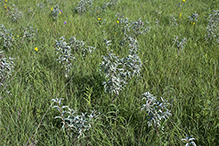 |
|||||
Plant |
|||||
 |
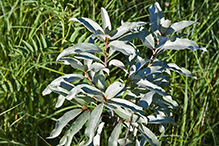 |
||||
Leaves |
|||||
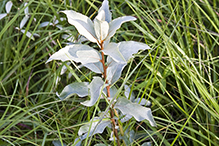 |
|||||

Slideshows |
||
| Eleagnus commutata Susanne Wiik |
||
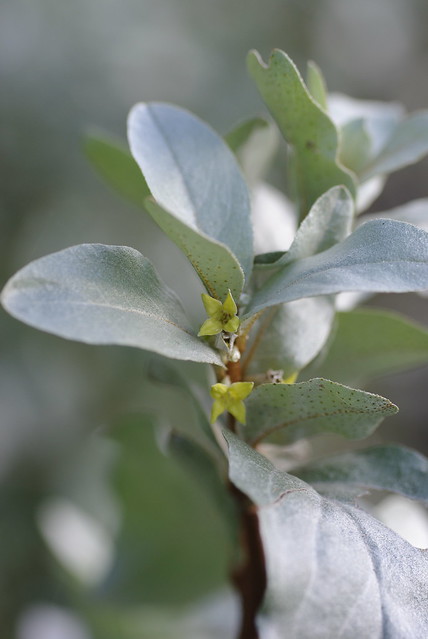
|
||
About
Præriesølvbusk, American silverberry |
||
| Elaeagnus commutata Matt Lavin |
||
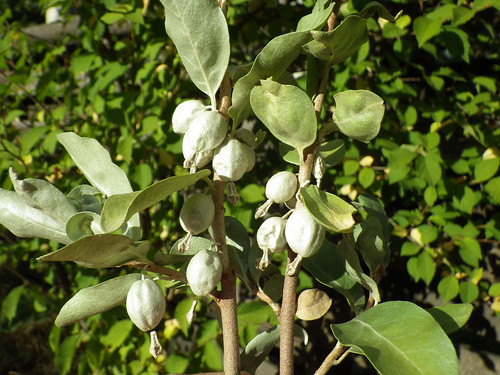
|
||
About
Native shrub 1-3 m tall, the brownish twigs and broad leaves distinguish this native species from the introduced E. angustifolia, forming thickets on banks of rivers and streams. |
||

Visitor Videos |
|||
Share your video of this plant. |
|||
| This button not working for you? Simply email us at info@MinnesotaSeasons.com. Attach a video, a YouTube link, or a cloud storage link. |
|||
Other Videos |
|||

Visitor Sightings |
|||||
Report a sighting of this plant. |
|||||
| This button not working for you? Simply email us at info@MinnesotaSeasons.com. Be sure to include a location. |
|||||
|
|||||
MinnesotaSeasons.com Sightings |
|||||

|
Created: Last Updated: © MinnesotaSeasons.com. All rights reserved. |
